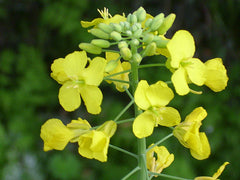Filipendula ulmaria, Meadowsweet
Sold out.
The flowers have a strong sweet smell, which for many people is sickly. The leaves are also aromatic, though the scent is very different from the flowers. The leaves are pleasantly aromatic. A good bee plant.
Requires a humus-rich moist soil in semi-shade. Succeeds in full sun only if the soil is reliably moist throughout the growing season. Dislikes dry or acid soils. Does well in marshy soils. Grows well in heavy clay soils.
The whole plant, but especially the leaves, was formerly used as a strewing herb, imparting an almond-like fragrance. Strongly aromatic, its delightful perfume would completely fill the room. Both flowers and leaves have been used in pot-pourri, retaining their scent for several months. The scent of the dried flowers becoming more and more pleasant with age.
A black dye is obtained from the roots. It is brown.
A yellow dye is obtained from the plant tops.
An essential oil obtained from the flower buds is used in perfumery.
Meadowsweet has a very long history of herbal use, it was one of the three most sacred herbs of the Druids.
Best sown in the autumn in a cold frame. The seed can also be sown in a cold frame in spring, germinating best at a temperature of 10 - 13°c.
Edible uses
Root - cooked.
Young leaves - cooked as a flavouring in soups. Young leaves, flowers and roots are brewed into a tea. The dried leaves are used as a flavouring, especially as a sweetener in herb teas.
The flowers are used as a flavouring in various alcoholic beverages and in stewed fruits. Adding them to wine or beer is said to make a very heady brew. They are also made into a syrup which can be used in cooling drinks and fruit salads.










